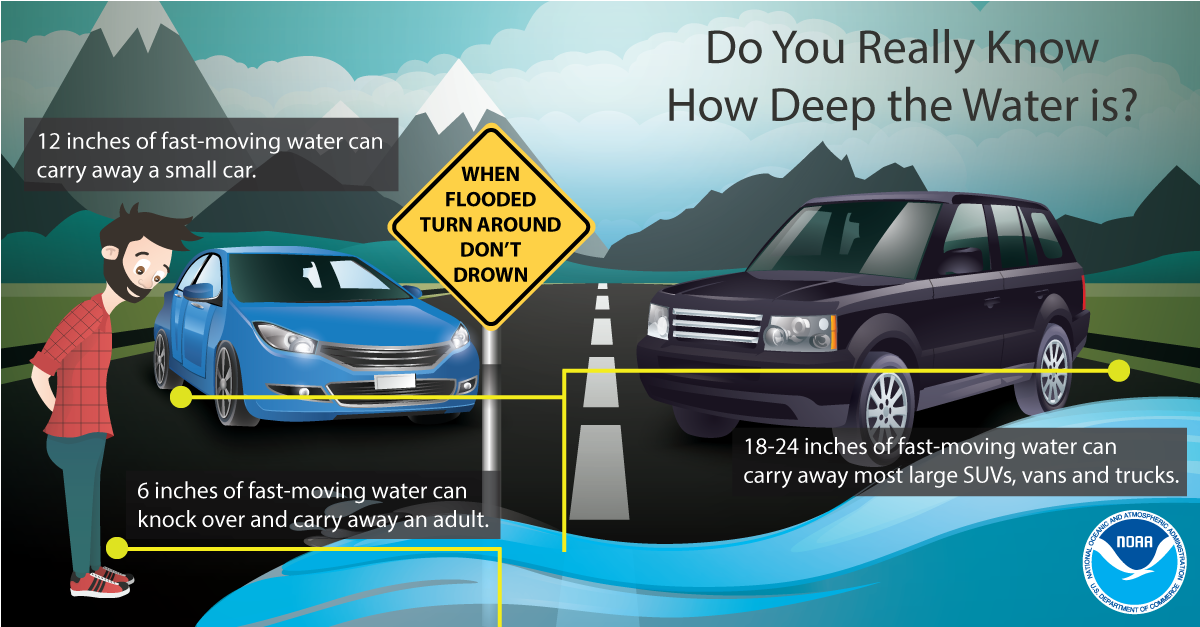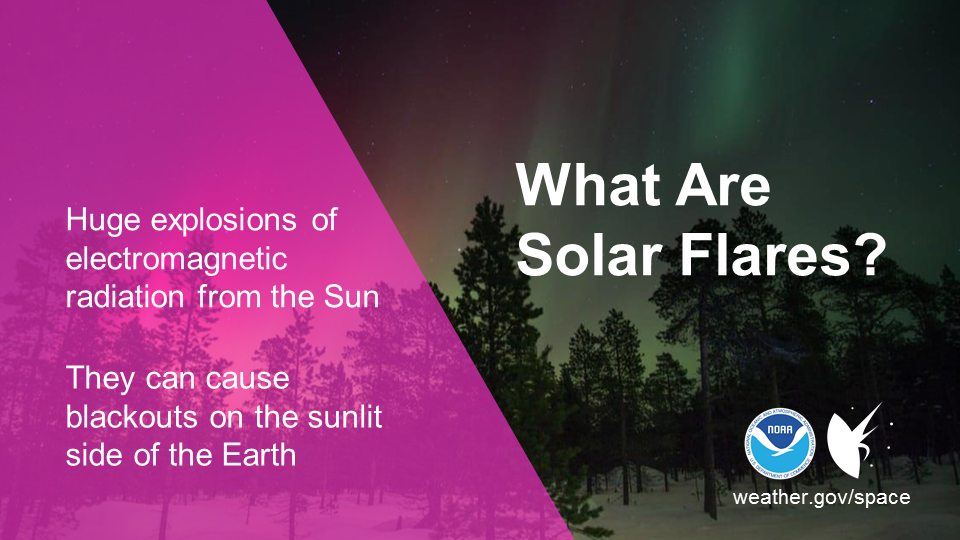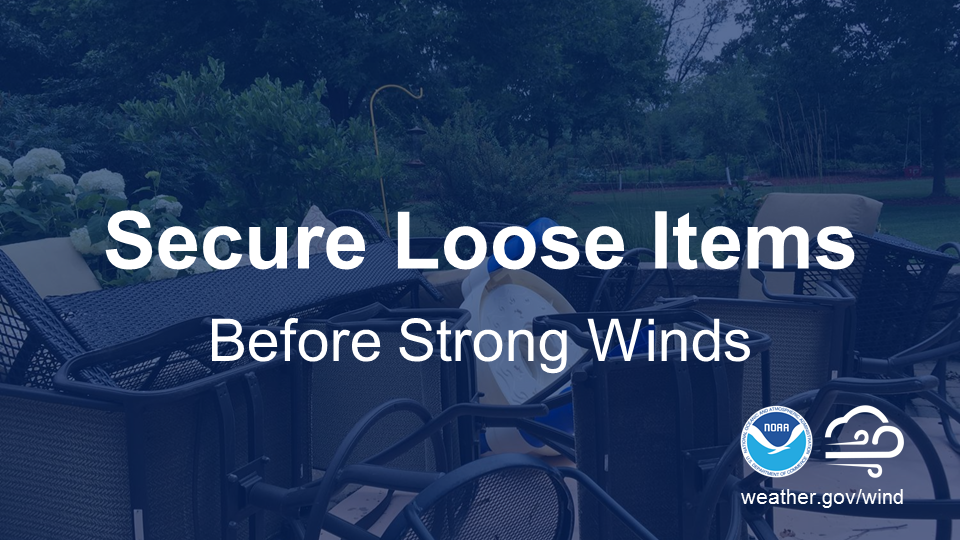Please help the NWS spread these important safety messages on social media! Everyone is welcome to use the text and images provided below to help the NWS build a #WeatherReady Nation. #WeatherReady Wednesday is a National Weather Service initiative to help spread weather safety messages each week. Each week you can pick a different topic to share. It can be based on the current weather or you can share one about weather that you don’t see in your area too often but others might if they are traveling.
Facebook
It’s #WeatherReady Wednesday! Time to get prepared! Don’t let bad weather sneak up on you! Get in the habit of checking weather.gov every morning before you go out. Make sure that you are ready for whatever the day may bring. #WinterSafety
Twitter
It’s #WeatherReady Wednesday! Don’t let bad weather sneak up on you! Get in the habit of checking weather.gov every morning before you go out. #WinterSafety

Facebook
It's #WeatherReady Wednesday! Know your risk.
It is NEVER safe to drive or walk into flood waters. It is impossible to know how deep the water is just by looking at it. Turn Around Don’t Drown! weather.gov/safety/flood-turn-around-dont-drown #FloodSafety
Twitter
It's #WeatherReady Wednesday! It is NEVER safe to drive or walk into floodwaters. Turn Around Don’t Drown. weather.gov/safety/flood-turn-around-dont-drown #FloodSafety

Facebook
Flooding can occur during any season. This #WeatherReady Wednesday, be prepared. Visit weather.gov/flood to learn more about flooding and how you can prepare before flooding happens. #FloodSafety
Twitter
This #WeatherReady Wednesday, be prepared for flooding. Visit weather.gov/flood #FloodSafety

Facebook
It’s #WeatherReady Wednesday! Slowing down is the most important thing you can do to drive safely in dense fog. Reduced visibilities can lead to motor vehicle accidents. Visibility is usually the lowest on bridges and near bodies of water. Learn more about #FogSafety by visiting weather.gov/fog. #WinterSafety
Twitter
It’s #WeatherReady Wednesday! Fog can be extremely dense on bridges over water. Please slow down when driving in dense fog. weather.gov/fog #FogSafety

Facebook
This #WeatherReady Wednesday, remember that driving in fog can be dangerous. Be on the lookout for sudden changes in visibility. The patchy nature of fog can lower visibility quickly especially if you are driving fast, so be sure to slow down. Visibility may also be lower near rivers. weather.gov/safety/fog #FogSafety #WinterSafety
Twitter
Hey, where’d everybody go? The patchy nature of #fog can lower visibility quickly—slow down, stay alert, and be #WeatherReady! weather.gov/safety/fog #FogSafety #WinterSafety

Facebook
It’s #WeatherReady Wednesday! Solar flares are huge explosions of electromagnetic radiation from the Sun lasting from minutes to hours. They are seen as enhancements in optical and extreme ultraviolet/x-ray wavelengths; and can be detected as bursts of noise in radio wavelengths. Solar flares occur in a large range of strengths, have emissions that travel at the speed of light, and reach Earth in eight minutes. They can cause radio blackouts on the sunlit side of the Earth. To learn about radio blackouts, visit www.swpc.noaa.gov/phenomena/solar-flares-radio-blackouts. #SpaceWeather
Twitter
It’s #WeatherReady Wednesday! Solar flares are energetic explosions from the Sun & can cause radio blackouts from minutes to hours. www.swpc.noaa.gov/phenomena/solar-flares-radio-blackouts #SpaceWeather

Facebook
It’s #WeatherReady Wednesday! Although the Earth’s magnetosphere, ionosphere, and atmosphere do a great job protecting us from hazardous space weather, it is still possible for space weather to cause power outages. Find out more about #SpaceWeather impacts at swpc.noaa.gov/impacts/electric-power-transmission.
Twitter
It’s #WeatherReady Wednesday! The Sun is the main source of #SpaceWeather, & it could even cause power outages! Find out more at swpc.noaa.gov/impacts/electric-power-transmission #SpaceWeather

Facebook
This #WeatherReady Wednesday, be aware that high winds can make driving dangerous. If driving during windy conditions, slow down and keep two hands on the wheel, avoid large trucks and trailers, and be aware for downed tree branches and power lines. Bridges and overpasses can be particularly dangerous to drive over when it is extremely windy so choose routes to avoid them. weather.gov/safety/wind-during #WindSafety #WinterSafety
Twitter
It’s #WeatherReady Wednesday! When windy: slow down, keep two hands on the wheel, avoid large trucks, powerlines & trees. weather.gov/safety/wind-during #WinterSafety

Facebook
It’s #WeatherReady Wednesday! Even the most common items become a dangerous objects when picked up and carried by the wind! When a High Wind Watch or a Severe Thunderstorm Watch is issued, secure outdoor items such as patio furniture, sports equipment and trash cans. Remove dead tree branches near your home before the next strong storm system blows through. weather.gov/safety/wind-during #WindSafety #WinterSafety
Twitter
It’s #WeatherReady Wednesday! Even the most common items become a dangerous objects when picked up and carried by the wind. weather.gov/safety/wind-during #WindSafety #WinterSafety

Facebook
It’s #WeatherReady Wednesday! Winter driving can be hazardous. One simple way to keep yourself and everyone on the road safe is to slow down. Remember, “Ice and snow, take it slow”. Learn more at weather.gov/winter #WinterSafety
Twitter
It’s #WeatherReady Wednesday! Do your part to keep everyone safe on the roads this winter. Learn more at weather.gov/winter #WinterSafety

Facebook
It’s #WeatherReady Wednesday! You love your pets, so keep them warm, dry, and well-fed this winter. weather.gov/winter #WinterSafety
Twitter
It’s #WeatherReady Wednesday! You love your pets, so keep them warm, dry, and well-fed this winter. weather.gov/winter #WinterSafety
